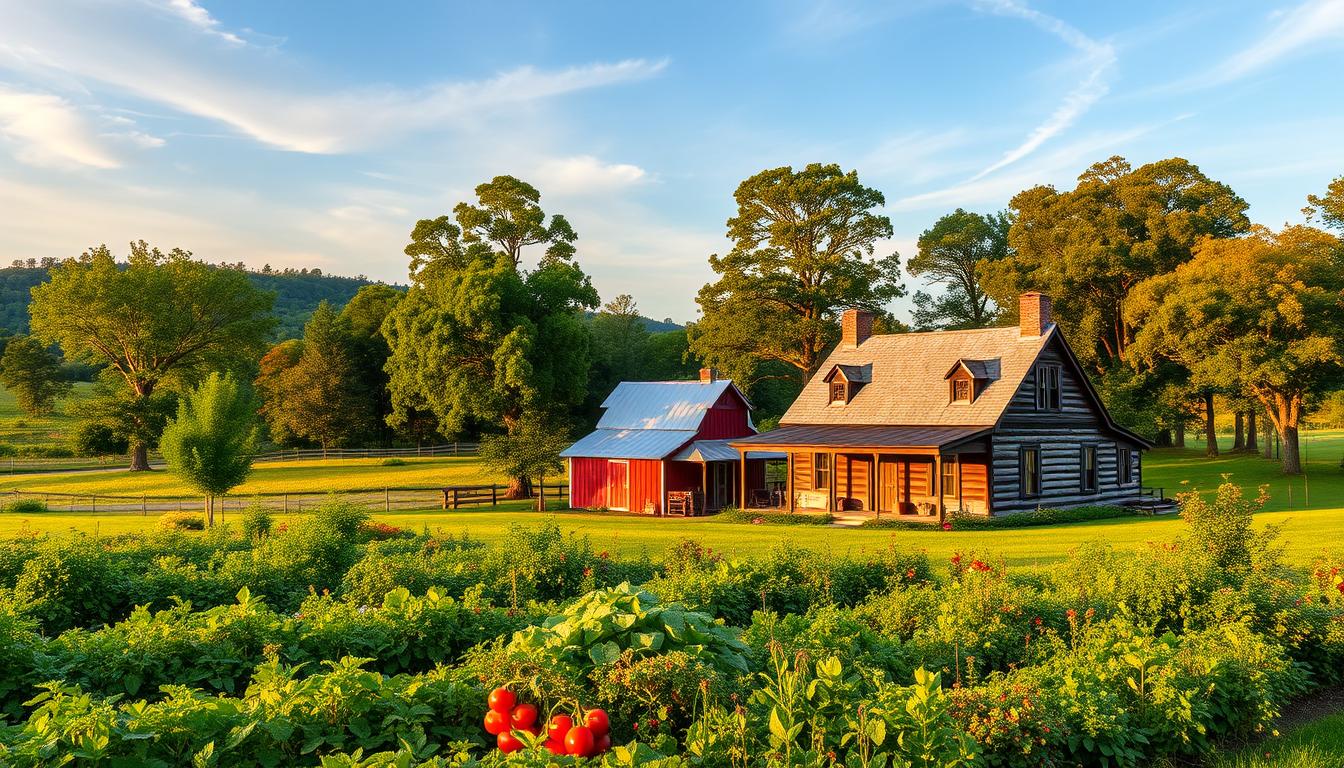The modern movement toward self-sufficient living has seen a 200% surge in interest over the past two years. People are increasingly drawn to a lifestyle that focuses on producing their own food and embracing natural practices. Whether you live in an apartment, a suburban home, or a rural area, this way of life is adaptable to your situation.
Starting your journey doesn’t require vast acreage or extensive resources. Instead, it’s about building skills step by step. Gardening, raising animals, and preserving food are core practices that can transform your daily routine. For example, urban chicken-keeping has become a popular way to introduce self-sufficiency into city life.
Many people mistakenly believe that a homestead requires a large property. However, small spaces can be just as effective. By focusing on your unique goals, you can create a fulfilling and sustainable lifestyle. The financial benefits, like reduced grocery bills, are an added bonus.
Key Takeaways
- Self-sufficient living is growing rapidly, with a 200% increase in interest.
- You can start in any living situation, from apartments to rural areas.
- Core practices include gardening, animal husbandry, and food preservation.
- Urban chicken-keeping is a great way to begin your journey.
- Define your own path to create a sustainable lifestyle.
What is Homesteading and Why Start Now?
More individuals are embracing a lifestyle centered on sustainability and independence. This movement, often called homesteading, focuses on producing your own food and resources. It’s not just about rural living; it’s a way of life that can thrive in urban and suburban settings too.
Since 2020, interest in this lifestyle has surged by 200%. The pandemic played a key role in this shift. Many people realized the importance of self-sufficiency during uncertain times. Today, 63% of beginners start with container gardening, while 45% of U.S. cities allow urban chicken-keeping.
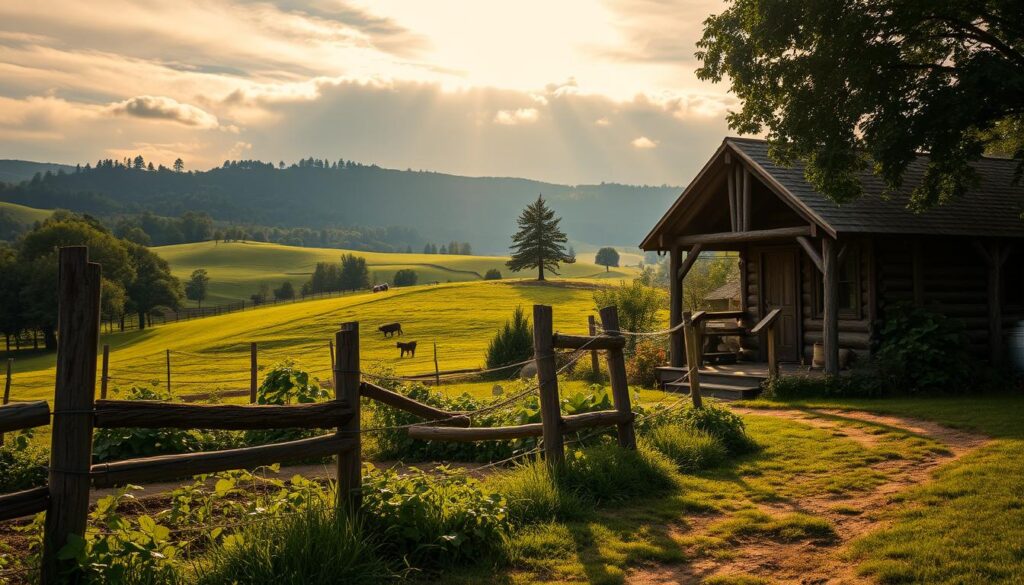
Modern homesteading can be broken into three main areas: 75% food production, 20% skill-building, and 5% community involvement. Whether you have a small backyard or a larger piece of land, this lifestyle is adaptable. Urban dwellers can grow herbs on balconies, while rural residents might raise livestock.
According to USDA statistics, home food production has increased significantly. A well-maintained vegetable garden can yield an average of $1,500 in savings annually. Beyond financial benefits, this hands-on lifestyle also improves mental health. It fosters a sense of accomplishment and connection to nature.
Climate change concerns are another driving factor. Many are turning to homesteading to ensure food security. For example, one family in an urban area now produces 40% of their own food. This shows that even small spaces can make a big impact.
Zoning laws vary by location, so it’s essential to research local regulations. Some areas have strict rules about livestock or garden structures. However, the concept of “micro-homesteading” has emerged, allowing people to maximize small spaces effectively.
| Feature | Urban Homesteading | Rural Homesteading |
|---|---|---|
| Space | Limited (balconies, rooftops) | Expansive (acres of land) |
| Activities | Container gardening, urban chickens | Large gardens, livestock raising |
| Community | Local urban farming groups | Neighbors with similar interests |
Define Your Homesteading Goals
Setting clear goals is the foundation of a successful homestead. Without a roadmap, it’s easy to feel overwhelmed or lose focus. Start by asking yourself what you want to achieve. Is it growing your own food, raising animals, or becoming fully self-sufficient? These things will shape your journey.
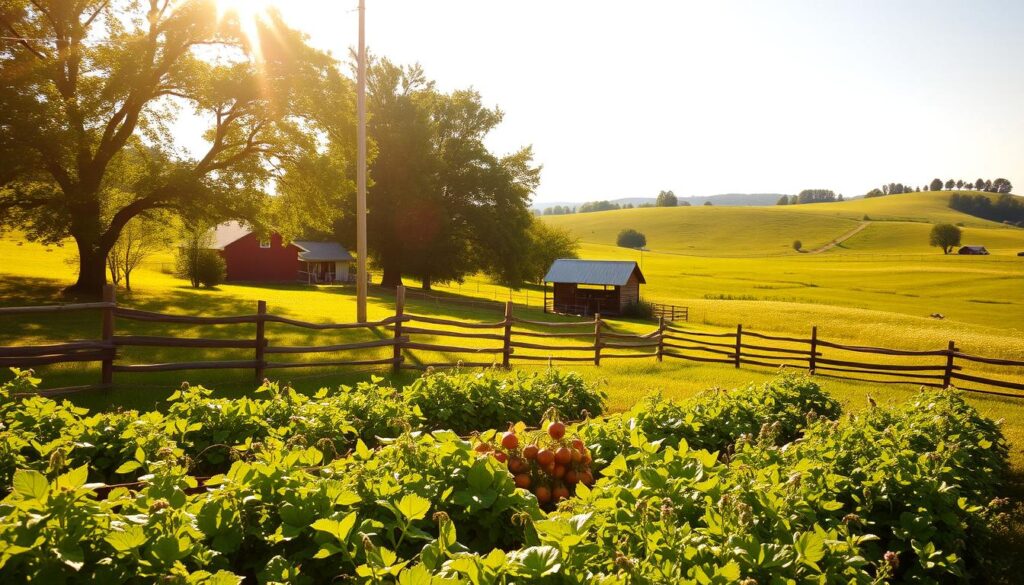
Ask yourself the right questions. What resources do you have? How much time can you dedicate? Are you doing this alone or with your family? These answers will help you create a realistic plan. For example, 78% of successful homesteaders use vision boards to visualize their goals. This simple tool can keep you motivated and on track.
Prioritize Your Goals
Not all goals are equal. Some tasks are urgent, while others can wait. Use a prioritization matrix to identify what needs immediate attention. For instance, setting up a garden might take precedence over building a chicken coop. A phased implementation strategy over 3-5 years can make the process manageable.
Consider the dynamics of your family. 87% of couples report challenges when starting a homestead. Open communication and shared responsibilities are key. Start small, like transitioning from store-bought to home-milled flour. This gradual approach reduces stress and increases success rates by 300%.
Finally, focus on essential skills first. Learn gardening basics before diving into advanced techniques. Seasonal planning cycles can help you stay organized. Remember, every homestead is unique. Define your path and enjoy the journey.
Start Small: Homesteading in Limited Spaces
Living in a small space doesn’t mean you can’t embrace self-sufficiency. Whether you’re in a city apartment or a suburban home, there are creative ways to grow your own food and raise animals. Start with simple projects and expand as you gain confidence.
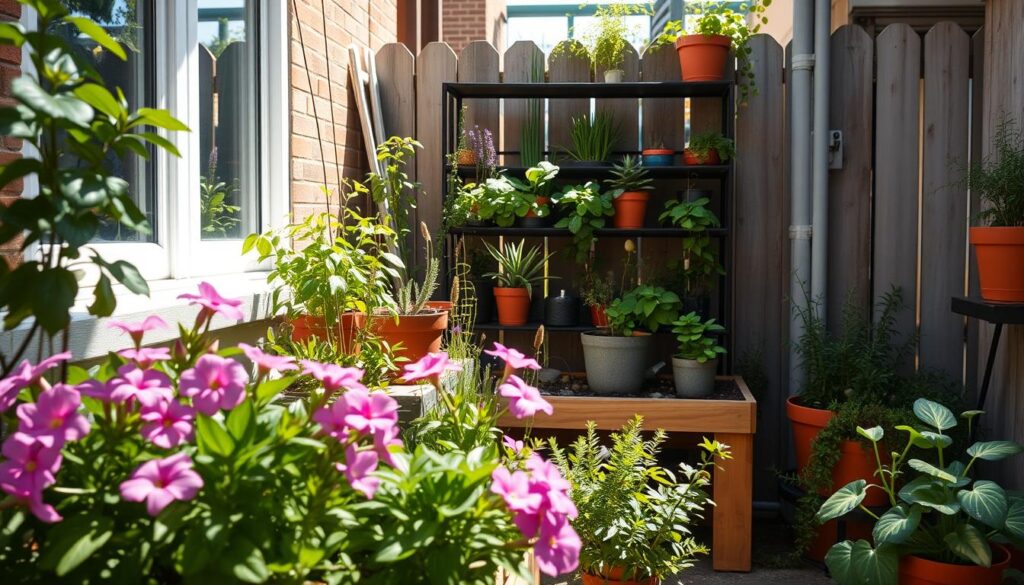
Gardening in Small Spaces
Vertical gardening is a game-changer for small areas. Using trellises or wall-mounted planters, you can grow plants like tomatoes, beans, and herbs. A 100 sq ft vertical setup can yield enough produce for a family of four.
Containers are another great option. Fabric pots and raised beds work well for root vegetables like potatoes. A 10-gallon grow bag can produce up to 15 lbs of potatoes. For beginners, starting with a simple garden setup is highly recommended.
Microgreens and herbs are perfect for apartment dwellers. A window herb garden costs as little as $25 to start. These small projects are low-cost and highly rewarding.
Raising Chickens in Urban Areas
Urban chicken-keeping is gaining popularity. Bantam chickens, for example, require only 2 sq ft per hen. Breeds like Silkies and Australorps are ideal for small spaces due to their calm nature and manageable size.
Before starting, check local ordinances. Some cities have specific rules about noise and coop placement. A well-designed coop can minimize noise and keep your neighbors happy.
Composting is another way to make the most of limited space. Bokashi and worm systems are compact and efficient. They turn kitchen scraps into nutrient-rich compost for your garden.
Succession planting ensures a continuous harvest. Plan your planting schedule to maximize yield. With careful planning, even a small area can provide fresh produce year-round.
Learn Essential Homesteading Skills
Mastering essential skills is the key to thriving in a self-sufficient lifestyle. Whether you’re growing your own vegetables or preserving food, these practices will help you build a sustainable routine. Start with the basics and expand your knowledge as you gain confidence.
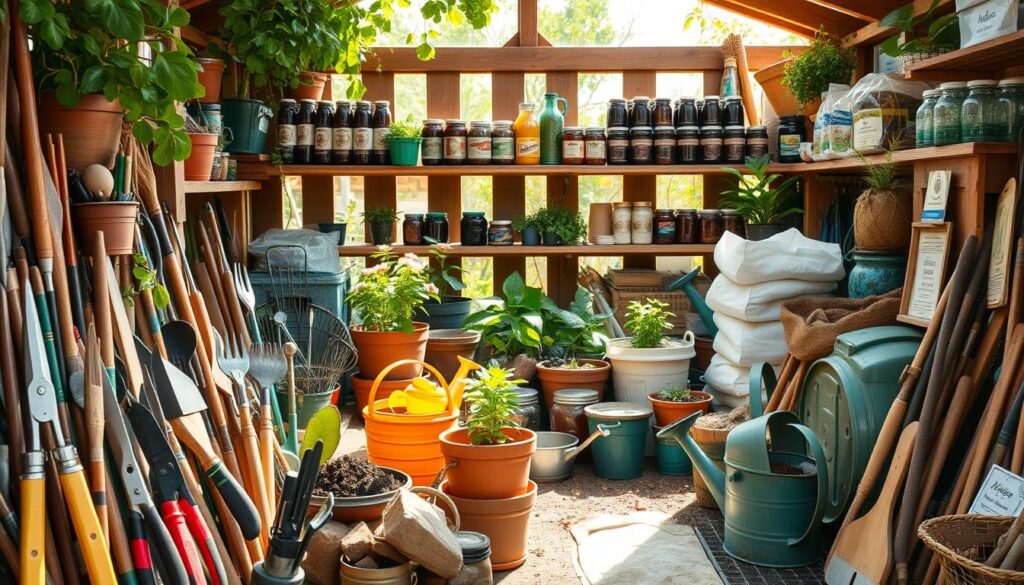
Gardening Basics
Successful gardening begins with understanding your soil. A soil test, either through a lab or a DIY kit, can reveal nutrient levels and pH balance. This ensures your plants get the right foundation to thrive.
Companion planting is another effective strategy. Pairing crops like tomatoes and basil can deter pests and improve growth. Crop rotation plans for small plots also prevent soil depletion and reduce waste.
Water management is crucial. Overwatering can harm plants, while underwatering stunts growth. Use drip irrigation systems to conserve water and ensure consistent hydration. For more tips, check out this gardening guide.
Food Preservation Techniques
Preserving food extends its shelf life and reduces spoilage. Blanching, for example, preserves 90% of vegetable nutrients before freezing. It’s a simple yet effective method for beginners.
Pressure canning is another reliable technique. It reduces spoilage by 75% and is ideal for preserving soups, meats, and vegetables. Always follow safety protocols to avoid contamination.
For those with limited space, root cellar alternatives like insulated boxes or basement storage can work wonders. Dehydrators are also efficient for drying herbs and fruits, saving space and reducing waste.
| Technique | Best For | Key Benefit |
|---|---|---|
| Blanching | Vegetables | Preserves 90% nutrients |
| Pressure Canning | Meats, Soups | Reduces spoilage by 75% |
| Dehydrating | Herbs, Fruits | Saves space, reduces waste |
Plan Your Homesteading Budget
Financial planning ensures your journey is both affordable and rewarding. Whether you’re starting with $500 or $5,000, a clear budget helps you allocate money wisely. This step is crucial for turning your dreams into reality.

Begin by listing all potential costs. Include essentials like seeds, tools, and animal feed. Don’t forget to account for unexpected expenses. A well-prepared budget reduces stress and keeps you on track.
Cutting Costs Without Sacrificing Quality
There are many ways to save money without compromising quality. For example, 65% of homesteaders use barter systems to exchange goods and services. This approach can significantly reduce your costs while building community connections.
Secondhand markets are another great resource. Platforms like Craigslist and local auctions often have affordable tools and equipment. DIY projects, such as building your own chicken coop, can also save you hundreds of dollars.
Investing in Long-Term Solutions
Some things are worth the upfront investment. Rainwater collection systems, for instance, can save you money on water bills over time. Solar panels are another long-term solution that reduces energy costs and increases sustainability.
Bulk buying co-ops for livestock feed can also lower expenses. These groups allow you to purchase in large quantities at discounted rates. Proper tool maintenance extends their lifespan, saving you money in the long run.
| Investment | Initial Cost | Long-Term Savings |
|---|---|---|
| Rainwater Collection | $300 | $100/year |
| Solar Panels | $5,000 | $1,200/year |
| Bulk Feed Co-op | $200 | $50/year |
Finally, consider the value of your land. A small plot can still support a thriving farm with careful planning. Focus on high-yield crops and efficient space usage to maximize your return on investment.
Choose the Right Property for Your Homestead
Selecting the ideal location is a critical step in building a sustainable lifestyle. The right property can support your goals, whether you’re growing food, raising animals, or creating a self-sufficient home. Start by evaluating the land and resources available to ensure it meets your needs.
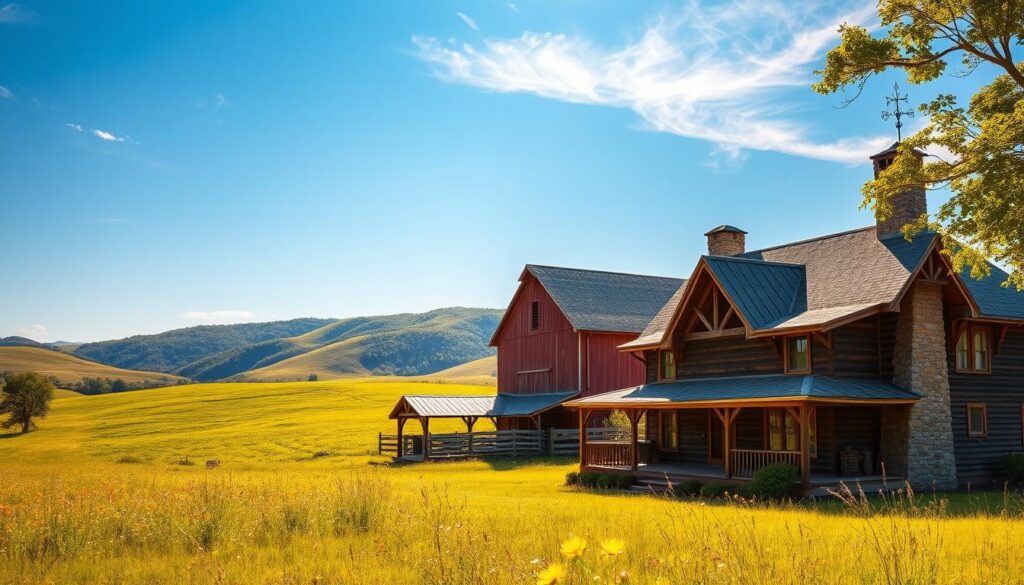
Assessing Land and Resources
Before committing to a property, conduct a thorough assessment. USDA soil maps can help identify prime agricultural land. Look for areas with good drainage and a slope of less than 30% for livestock grazing. Solar exposure analysis tools can determine the best spots for gardens or solar panels.
Water access is another key factor. Compare well systems to municipal water sources to understand costs and reliability. A perc test is essential for septic systems, ensuring the land can support your infrastructure needs.
Consider the area’s flood zone certification and wildlife activity. Preventing conflicts with local animals can save you time and resources. Road access is also crucial, especially for rural properties.
Zoning Laws and Regulations
Understanding local zoning laws is vital. Some areas have restrictions on livestock, structures, or land use. Easement negotiation strategies can help you secure access to shared resources or pathways.
Multi-use structure design principles maximize space efficiency. For example, a barn can serve as both a shelter for animals and storage for tools. Timber value assessment guidelines can also help you evaluate the land’s potential for additional income.
Plan for future expansion by choosing a property with room to grow. A well-thought-out site plan ensures your farm can evolve with your needs.
| Factor | Key Considerations |
|---|---|
| Soil Quality | Use USDA soil maps for analysis |
| Water Access | Compare wells vs. municipal systems |
| Zoning Laws | Check livestock and structure regulations |
| Future Expansion | Plan for additional buildings or gardens |
Start Your Homesteading Journey Today
Embarking on a self-sufficient lifestyle is easier with the right support system. Building a strong community and learning from others can make your journey smoother and more rewarding. Whether you’re just starting or looking to expand your skills, connecting with like-minded individuals is key.
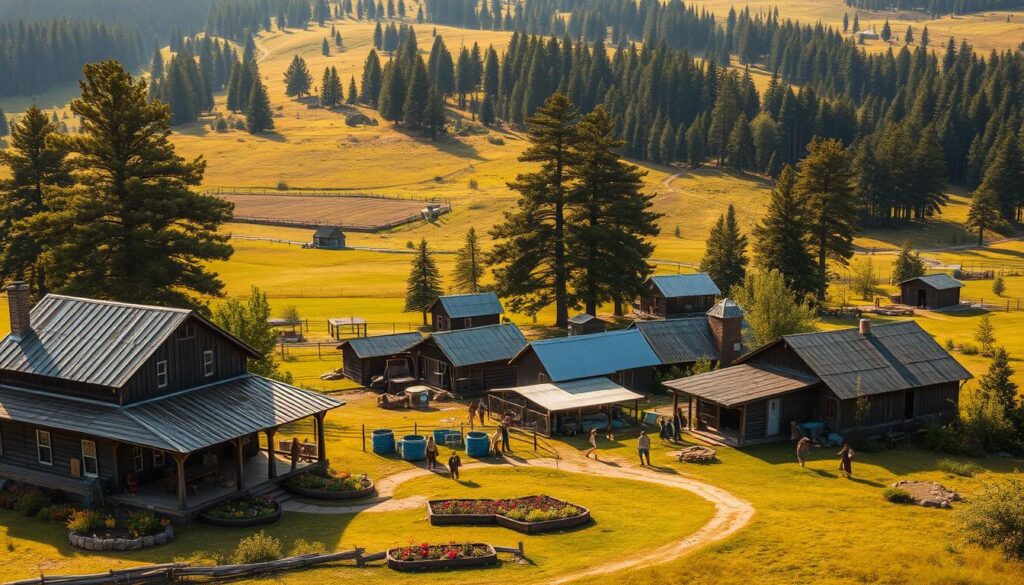
Building Your Homesteading Network
Online forums are a great place to start. 92% of homesteaders use these platforms to share tips, ask questions, and find inspiration. Platforms like Reddit and Facebook groups offer a wealth of knowledge. Look for active groups with positive engagement to ensure you’re getting reliable advice.
Apprenticeships are another powerful tool. They increase success rates by 58%, giving you hands-on experience and mentorship. Local farms or homesteads often offer opportunities to learn essential skills. This is a great way to gain confidence and build relationships in the community.
Volunteering and Learning from Others
Volunteering at local farms or community gardens is a fantastic way to learn. It allows you to gain practical skills while contributing to a larger cause. Many organizations also offer workshops or classes, which can serve as a guide for your own projects.
Skill-sharing exchanges are becoming increasingly popular. These initiatives allow you to trade expertise with others, saving time and resources. For example, you might teach someone how to preserve food in exchange for help building a chicken coop.
- Visit your local extension office for a resource guide tailored to your area.
- Consider pursuing a Master Gardener certification to deepen your knowledge.
- Search for farm internships to gain hands-on experience.
- Join social media groups and use a vetting checklist to find reliable ones.
- Develop a crisis support network to prepare for unexpected challenges.
By building a strong network and learning from others, you’ll set yourself up for success. Every post you read, every connection you make, and every skill you learn brings you closer to your goals.
Homesteading for Beginners: Overcoming Challenges
Facing challenges is a natural part of building a self-sufficient lifestyle. Whether it’s dealing with predator losses or managing crop failures, setbacks can feel overwhelming. However, with the right strategies, you can turn these obstacles into valuable learning experiences.
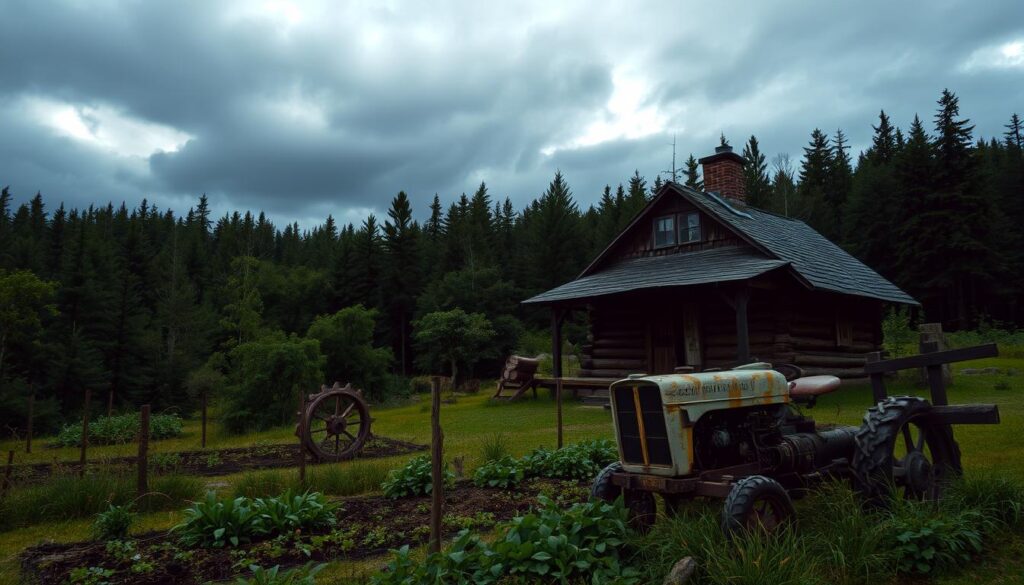
Dealing with Setbacks
Setbacks are common, especially for beginners. For example, 68% of new homesteaders face predator losses. Protecting your animals requires cost-effective solutions like reinforced fencing or secure coop designs. These measures can save you time and stress in the long run.
Crop failures are another challenge. Having a recovery plan, such as replanting or diversifying your garden, can help. Keeping an animal illness first-aid kit on hand ensures you’re prepared for emergencies. These small steps can make a big difference.
Staying Motivated
Maintaining motivation is crucial. Journaling reduces burnout by 40%, making it a powerful tool for tracking progress. Writing a post about your journey can also help you reflect on your achievements and identify areas for improvement.
Seasonal affective disorder can impact your energy levels. Combat this by setting goal reassessment checkpoints and engaging in resilience-building exercises. Surrounding yourself with a supportive community can also keep you inspired.
| Challenge | Solution |
|---|---|
| Predator Losses | Reinforced fencing, secure coop designs |
| Crop Failures | Recovery plans, diversified planting |
| Burnout | Journaling, community support |
Conclusion: Your Homesteading Journey Awaits
Building a homestead is more than a dream—it’s a way of life. Whether you’re starting small or planning a larger transformation, every step brings you closer to self-sufficiency. Your family can thrive by embracing this fulfilling lifestyle.
Begin with a clear plan and focus on long-term goals. From maintaining your space to passing down knowledge, every effort contributes to your legacy. Projects like orchards or ponds can create lasting value for future generations.
Stay committed to continuous learning. Annual reviews and community involvement keep your journey on track. When challenges arise, remember why you started. Your homestead is a reflection of your dreams and hard work.
Take the first step today. Your self-sufficient way of life is waiting to unfold.

